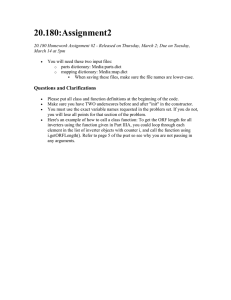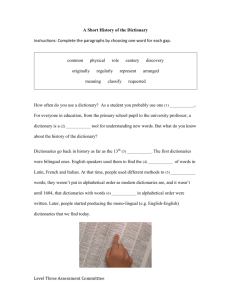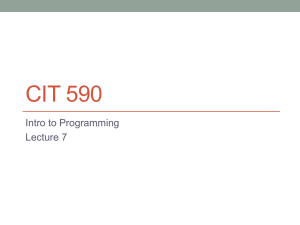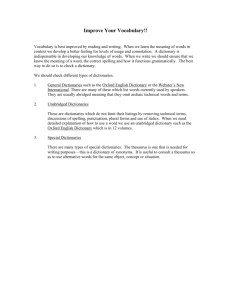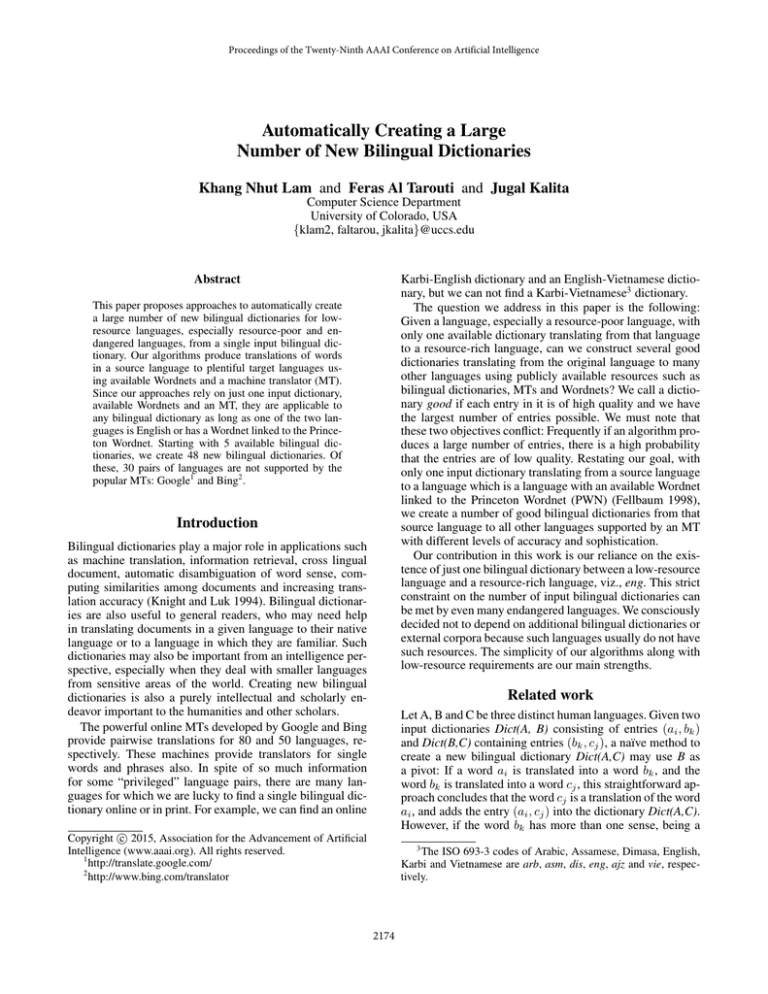
Proceedings of the Twenty-Ninth AAAI Conference on Artificial Intelligence
Automatically Creating a Large
Number of New Bilingual Dictionaries
Khang Nhut Lam and Feras Al Tarouti and Jugal Kalita
Computer Science Department
University of Colorado, USA
{klam2, faltarou, jkalita}@uccs.edu
Abstract
Karbi-English dictionary and an English-Vietnamese dictionary, but we can not find a Karbi-Vietnamese3 dictionary.
The question we address in this paper is the following:
Given a language, especially a resource-poor language, with
only one available dictionary translating from that language
to a resource-rich language, can we construct several good
dictionaries translating from the original language to many
other languages using publicly available resources such as
bilingual dictionaries, MTs and Wordnets? We call a dictionary good if each entry in it is of high quality and we have
the largest number of entries possible. We must note that
these two objectives conflict: Frequently if an algorithm produces a large number of entries, there is a high probability
that the entries are of low quality. Restating our goal, with
only one input dictionary translating from a source language
to a language which is a language with an available Wordnet
linked to the Princeton Wordnet (PWN) (Fellbaum 1998),
we create a number of good bilingual dictionaries from that
source language to all other languages supported by an MT
with different levels of accuracy and sophistication.
Our contribution in this work is our reliance on the existence of just one bilingual dictionary between a low-resource
language and a resource-rich language, viz., eng. This strict
constraint on the number of input bilingual dictionaries can
be met by even many endangered languages. We consciously
decided not to depend on additional bilingual dictionaries or
external corpora because such languages usually do not have
such resources. The simplicity of our algorithms along with
low-resource requirements are our main strengths.
This paper proposes approaches to automatically create
a large number of new bilingual dictionaries for lowresource languages, especially resource-poor and endangered languages, from a single input bilingual dictionary. Our algorithms produce translations of words
in a source language to plentiful target languages using available Wordnets and a machine translator (MT).
Since our approaches rely on just one input dictionary,
available Wordnets and an MT, they are applicable to
any bilingual dictionary as long as one of the two languages is English or has a Wordnet linked to the Princeton Wordnet. Starting with 5 available bilingual dictionaries, we create 48 new bilingual dictionaries. Of
these, 30 pairs of languages are not supported by the
popular MTs: Google1 and Bing2 .
Introduction
Bilingual dictionaries play a major role in applications such
as machine translation, information retrieval, cross lingual
document, automatic disambiguation of word sense, computing similarities among documents and increasing translation accuracy (Knight and Luk 1994). Bilingual dictionaries are also useful to general readers, who may need help
in translating documents in a given language to their native
language or to a language in which they are familiar. Such
dictionaries may also be important from an intelligence perspective, especially when they deal with smaller languages
from sensitive areas of the world. Creating new bilingual
dictionaries is also a purely intellectual and scholarly endeavor important to the humanities and other scholars.
The powerful online MTs developed by Google and Bing
provide pairwise translations for 80 and 50 languages, respectively. These machines provide translators for single
words and phrases also. In spite of so much information
for some “privileged” language pairs, there are many languages for which we are lucky to find a single bilingual dictionary online or in print. For example, we can find an online
Related work
Let A, B and C be three distinct human languages. Given two
input dictionaries Dict(A, B) consisting of entries (ai , bk )
and Dict(B,C) containing entries (bk , cj ), a naı̈ve method to
create a new bilingual dictionary Dict(A,C) may use B as
a pivot: If a word ai is translated into a word bk , and the
word bk is translated into a word cj , this straightforward approach concludes that the word cj is a translation of the word
ai , and adds the entry (ai , cj ) into the dictionary Dict(A,C).
However, if the word bk has more than one sense, being a
c 2015, Association for the Advancement of Artificial
Copyright Intelligence (www.aaai.org). All rights reserved.
1
http://translate.google.com/
2
http://www.bing.com/translator
3
The ISO 693-3 codes of Arabic, Assamese, Dimasa, English,
Karbi and Vietnamese are arb, asm, dis, eng, ajz and vie, respectively.
2174
word. Entries in the dictionaries we create are of the form
< LexicalU nit, Sense1 >, < LexicalU nit, Sense2 >,....
polysemous word, this method might make wrong conclusions. For example, if the word bk has two distinct senses
which are translated into words cj1 and cj2 , the straightforward method will conclude that the word ai is translated
into both the word cj1 and the word cj2 , which may be incorrect. This problem is called the ambiguous word sense
problem. After obtaining an initial bilingual dictionary, past
researchers have used several approaches to mitigate the effect of the ambiguity problem. All the methods used for
word sense disambiguation use Wordnet distance between
source and target words in some ways, in addition to looking at dictionary entries in forward and backward directions
and computing the amount of overlap or match to obtain disambiguation scores (Tanaka and Umemura 1994), (Gollins
and Sanderson 2001), (Bond et al. 2001), (Ahn and Frampton 2006), (Bond and Ogura 2008), (Mausam et al. 2010),
(Lam and Kalita 2013) and (Shaw et al. 2013). The formulas used and the names used for the disambiguation scores
by different authors are different. Researchers have also
merged information from sources such as parallel corpora or
comparable corpora (Nerima and Wehrli 2008), (Otero and
Campos 2010) and a Wordnet (Istvan and Shoichi 2009).
Some researchers have also extracted bilingual dictionaries
from parallel corpora or comparable corpora using statistical methods (Brown 1997), (Haghighi et al. 2008), (Nakov
and Ng 2009), (Heja 2010), (Ljubesic and Fiser 2011) and
(Bouamor, Semmar, and Zweigenbaum 2013).
The primary similarity among these methods is that they
work with languages that already possess several lexical resources or these approaches take advantage of related languages (that have some lexical resources) by using such languages as intermediary. The accuracies of bilingual dictionaries created from available dictionaries and Wordnets are
usually high. However, it is expensive to create such original
lexical resources and they do not always exist for many languages. For example, such resources do not exist for most
major languages of India, some spoken by hundred of millions. The same holds for many other widely spoken languages from around the world. In addition, these methods
can only generate one or just a few new bilingual dictionaries using published approaches.
In this paper, we propose methods for creating a significant number of bilingual dictionaries from a single available bilingual dictionary, which translates a source language
to a resource-rich language with an available Wordnet. We
use publicly available Wordnets in several resource-rich languages and a publicly available MT as well.
Proposed approaches
This section describes approaches to create new bilingual
dictionaries Dict(S,D), each of which translates a word in
language S to a word or multiword expression in a destination language D. Our starting point is just one existing bilingual dictionary Dict(S,R), where S is the source language
and R is an “intermediate helper” language. We require that
the language R has an available Wordnet linked to the PWN.
We do not think this is a big imposition since the PWN and
other Wordnets are freely available for research purposes.
Direct translation approach (DT)
We first develop a direct translation method which we call
the DT approach (see Algorithm 1). The DT approach uses
transitivity to create new bilingual dictionaries from existing dictionaries and an MT. An existing dictionary Dict(S,R)
contains alphabetically sorted LexicalUnits in a source language S and each has one or more Senses in the language R. We call such a sense SenseR . To create a new
bilingual dictionary Dict(S,D), we simply take every pair
¡LexicalUnit,SenseR ¿ in Dict(S,R) and translate SenseR to
D to generate translation candidates candidateSet (lines 24). When there is no translation of SenseR in D, we skip that
pair ¡LexicalUnit,SenseR ¿. Each candidate in candidateSet becomes a SenseD in language D of that LexicalUnit.
We add the new tuple ¡LexicalU nit, SenseD ¿ to Dict(S,D)
(lines 5-7).
Algorithm 1 DT algorithm
Input: Dict(S, R)
Output: Dict(S, D)
1: Dict(S, D) := φ
2: for all LexicalEntry ∈ Dict(S, R) do
3:
for all SenseR ∈ LexicalEntry do
4:
candiateSet= translate(SenseR ,D)
5:
for all candidate ∈ candiateSet do
6:
SenseDj = candidate
7:
add tuple <LexicalUnit,SenseDj > to Dict(S,D)
8:
end for
9:
end for
10: end for
An example of generating an entry for a Dict(asm,vie) using the DT approach from an input Dict(asm,eng) is presented in Figure 1.
Bilingual dictionary
An entry in a dictionary, called LexicalEntry, is a 2-tuple
¡LexicalUnit, Definition¿. A LexicalUnit is a word or phrase
being defined, the so-called definiendum (Landau 1984). A
list of entries sorted by the LexicalUnit is called a lexicon
or a dictionary. Given a LexicalUnit, the Definition associated with it usually contains its class and pronunciation, its
meaning, and possibly additional information. The meaning
associated with it can have several Senses. A Sense is a discrete representation of a single aspect of the meaning of a
Using publicly available Wordnets as intermediate
resources (IW)
To handle ambiguities in the dictionaries created, we propose the IW approach as in Figure 2 and Algorithm 2.
For each SenseR in every given LexicalEntry from
Dict(S,R), we find all Offset-POSs4 in the Wordnet of
4
2175
Synset is a set of cognitive synonyms. Offset-POS refers to the
tionary Dict(S,D) (Algorithm 2, lines 8-10). We can vary the
Wordnets and the numbers of Wordnets used during experiments, producing different results.
Algorithm 2 IW algorithm
Input: Dict(S,R)
Output: Dict(S, D)
1: Dict(S, D) := φ
2: for all LexicalEntry ∈ Dict(S,R) do
3:
for all SenseR ∈ LexicalEntry do
4:
candidateSet := φ
5:
Find all Offset-POSs of synsets containing SenseR
from the R Wordnet
6:
candidatSet = FindCandidateSet (Offset-POSs,
D)
7:
sort all candidate in descending order based on
their rank values
8:
for all candidate ∈ candidateSet do
9:
SenseD =candidate.word
10:
add tuple ¡LexicalUnit,SenseD ¿ to Dict(S,D)
11:
end for
12:
end for
13: end for
Figure 1: An example of DT approach for generating a new dictionary Dict(asm,eng). In Dict(asm,eng), the word “diha-juguti” in
asm has two translations in eng “suggestion” and “advice”, which
are translated to vie as “đề nghị” and “tư vấn”, respectively, using
the Bing Translator. Therefore, in the new Dict(asm,vie), the word
“diha-juguti” has two translations in vie which are “đề nghị” and
“tư vấn”.
Algorithm 3 FindCandidateSet (Offset-POSs,D)
Input: Offset-POSs, D
Output: candidateSet
1: candidateSet := φ
2: for all Offset-POS ∈ Offset-POSs do
3:
for all word in the Offset-POS extracted from the
PWN and other available Wordnets linked to the
PWN do
4:
candidate.word= translate (word, D)
5:
candidate.rank++
6:
candidateSet += candidate
7:
end for
8: end for
9: return candidateSet
Figure 2: The IW approach for creating a new bilingual dictionary
the language R to which SenseR belongs (Algorithm 2,
lines 2-5). Then, we find a candidate set for translations from the Offset-POSs and the destination language
D using Algorithm 3. For each Offset-POS from the extracted Offset-POSs, we obtain each word belonging to that
Offset-POS from different Wordnets (Algorithm 3, lines 23) and translate it to D using a MT to generate translation
candidates (Algorithm 3, line 4). We add translation candidates to the candidateSet (Algorithm 3, line 6). Each candidate in the candidateSet has 2 attributes: a translation
of the word word in the target language D, the so-called
candidate.word and the occurrence count or the rank value
of the candidate.word, the so-called candidate.rank. A
candidate with a greater rank value is more likely to become a correct translation. Candidates having the same
ranks are treated similarly. Then, we sort all candidates in
the candidateSet in descending order based on their rank
values (Algorithm 2, line 7), and add them into the new dic-
Figure 3 shows an example of creating entries for
Dict(asm,arb) from Dict(asm,eng) using the IW approach.
Experimental results
Data sets used
Our approach is general, but to demonstrate the effectiveness
and usefulness of our algorithms, we have carefully selected
a few languages for experimentation. These languages include widely-spoken languages with limited computational
resources such as arb and vie; a language spoken by tens
of millions in a specific region within India, viz., asm with
almost no resources; and a couple of languages in the UNESCO’s list of endangered languages, viz., dis and ajz both
from northeast India, again with almost no resources at all.
We work with 5 existing bilingual dictionaries that
translate a given language to a resource-rich language,
which happens to be eng in our experiments: Dict(arb,eng)
offset for a synset with a particular POS, from the beginning of its
data file. Words in a synset have the same sense.
2176
Figure 4: New bilingual dictionaries created
the new dictionaries created change. The Microsoft Translator Java API8 is used as another main resource. The Microsoft Translator supports translations for 50 languages.
In our experiments, we create dictionaries from any of
{ajz, arb, asm, dis, vie} to any non-eng language supported
by the Microsoft Translator, e.g., arb, Chinese (cht), German
(deu), Hmong Daw (mww), Indonesian (ind), Korean (kor),
Malay (zlm), Thai (tha), Spanish (spa) and vie, as shown in
Figure 4.
Figure 3: Example of generating new LexicalEntrys for
Dict(asm,arb) using the IW approach from Dict(asm,eng). The
word ”diha-juguti” in asm has two senses as in Figure 2: “suggestion” and “ advice”. This example only shows the IW approach
to find the translation of ”diha-juguti” with the sense “suggestion”.
We find all offset-POSs in the PWN containing ”suggestion”. Then,
we extract words belonging to all offset-POSs from the PWN,
FinnWordnet, WOLF and Japanese Wordnet. Next, we translate extracted words to arb and rank them based on the occurrence counts.
According to the ranks, the best translation of ”diha-juguti” in asm,
which has the greatest rank value, is the word ”almshwrh” in arb.
Results and human evaluation
Ideally, evaluation should be performed by volunteers who
are fluent in both source and target languages. However, for
evaluating created dictionaries, we could not recruit any individuals who are experts in two appropriate languages9 .
Hence, every dictionary is evaluated by 2 people sitting together, one using the target language as mother tongue, and
the other the source language. Each volunteer pair was requested to evaluate using a 5-point scale – 5: excellent, 4:
good, 3: average, 2: fair and 1: bad. For selecting the samples to evaluate, we follow the concept of “simple random
method” (Hays and Winkler 1971). According to the general rules of thumb, we can be confident of the normal approximation whenever the sample size is at least 30 (Ross
2010, page 310). To achieve reliable judgment, we randomly
picked 100 translations from every dictionary created.
To study the effect of available resources used to create
our new dictionaries, we first evaluate the input dictionaries. The average score of LexicalEntrys in the input dictionaries Dict(arb,eng), Dict(asm,eng) and Dict(vie,eng) are
3.58, 4.65 and 3.77, respectively. This essentially means that
Dict(asm,eng) is of almost excellent quality, while the other
two are of reasonably good quality. These are the best dictionaries we could find. The average score and the number
of LexicalEntrys in the dictionaries we create using the DT
approach are presented in Table 1. We believe that if we find
and Dict(vie,eng) supported by Panlex5 ; Dict(ajz,eng) and
Dict(dis,eng) supported by Xobdo6 ; one Dict(asm,eng) created by integrating two dictionaries Dict(asm,eng) provided by Panlex and Xobdo. The numbers of entries in
Dict(ajz,eng), Dict(arb,eng), Dict(asm-eng), Dict(dis,eng)
and Dict(vie,eng) are 4682, 53194, 76634, 6628 and 231665,
respectively. Many LexicalEntrys in some of our input dictionaries have no POS information. For example, 100% and
6.63% LexicalEntrys in Dict(arb,eng) and Dict(vie,eng), respectively, do not have POS.
To solve the problem of ambiguities, we use the PWN
and Wordnets in several other languages linked to the
PWN provided by the Open Multilingual Wordnet project
(Bond and Foster 2013): FinnWordnet (Linden and Carlson
2010) (FWN), WOLF (Sagot and Fiser 2008) (WWN) and
Japanese Wordnet (Isahara et al. 2008) (JWN). We choose
these Wordnets because they are already aligned with the
PWN, cover a large number of synsets of the about 5,000
most frequently used word senses and are available online7
for free. Depending on which Wordnets are used and the
number of intermediate Wordnets, the sizes and qualities of
8
https://datamarket.azure.com/dataset/bing/microsofttranslator
This is not surprising. Considering languages we focus on are
disparate belonging to different classes, with provenance spread
out around the world, and frequently resource poor and even endangered. For example, it is almost impossible to find an individual
fluent in the endangered language Karbi and Vietnamese.
9
5
http://panlex.org/
http://www.xobdo.org/
7
http://compling.hss.ntu.edu.sg/omw/
6
2177
Dict.
arb-deu
arb-vie
asm-spa
vie-arb
Score
4.29
3.66
4.81
2.67
Entries
1,323
2,048
20,678
85,173
Dict.
arb-spa
asm-arb
asm-vie
vie-spa
Score
3.61
4.18
4.57
3.55
Entries
1,709
47,416
42,743
35,004
Dict.
we create
arb
vie
asm
arb
asm
vie
vie
arb
Table 1: The average score and the number of LexicalEntrys
in the dictionaries created using the DT approach.
Dict.
we create
Top 1
arb-vie Top 3
Top 5
Top 1
asm-arb Top 3
Top 5
Top 1
asm-vie Top 3
Top 5
Top 1
vie-arb Top 3
Top 5
A
3.42
3.33
2.99
4.51
4.03
3.78
4.43
3.93
3.74
3.11
2.47
2.54
Wordnets used
B
C
3.65 3.33
3.58 3.76
3.04 3.08
3.83 4.69
3.75 3.80
3.85 3.42
4.31 3.86
3.59 3.33
3.34 3.4
2.94 2.78
2.72 2.61
2.37 2.60
D
3.71
3.61
3.31
4.67
4.10
4.00
4.43
3.94
2.91
3.11
3.02
2.73
Top1
Top3
Top5
Top1
Top3
Top5
Top1
Top3
Top5
Top1
Top3
Top5
A
1,786
3,434
4,123
27,039
70,940
104,732
25,824
64,636
92,863
63,792
152,725
210,220
Wordnets used
B
2,132
4,611
5,926
27,336
76,695
118,261
26,898
73,652
111,977
65,606
177,666
261,392
C
2,169
4,908
6,529
27,449
78,979
125,087
27,064
76,496
120,090
66,040
183,098
278,117
D
2,200
5,110
6,853
27,468
79,585
126,779
27,129
77,341
122,028
65,862
185,221
282,398
Table 3: The number of LexicalEntrys in the dictionaries we
create using the IW approach.
Dict.
we create
arb-deu
arb-spa
asm-spa
vie-spa
Table 2: The average score of LexicalEntrys in the dictionaries we create using the IW approach.
Top 1
Score Entries
4.27
1,717
4.54
2,111
4.65
26,224
3.42
61,477
Top 3
Score
Entries
4.21
3,859
4.27
4,673
4.40
72,846
3.38
159,567
Table 4: The average score of entries and the number of LexicalEntrys in some other bilingual dictionaries constructed
using 4 Wordnets: PWN, FWN, JWN and WWN.
“better” input dictionaries, our results will be commensurately better.
The average scores and the numbers of LexicalEntrys in
the dictionaries created by the IW approach are presented
in Table 2 and Table 3, respectively. In these tables, Top n
means dictionaries created by picking only translations with
the top n highest ranks for each word, A: dictionaries created
using PWN only; B: using PWN and FWN; C: using PWN,
FWN and JWN; D: using PWN, FWN, JWN and WWN.
The method using all 4 Wordnets produces dictionaries with
the highest scores and the highest number of LexicalEntrys
as well.
The number of LexicalEntrys and the accuracies of the
newly created dictionaries definitely depend on the sizes and
qualities of the input dictionaries. Therefore, if the sizes and
the accuracies of the dictionaries we create are comparable
to those of the input dictionaries, we conclude that the new
dictionaries are acceptable. Using four Wordnets as intermediate resources to create new bilingual dictionaries increases
not only the accuracies but also the number of LexicalEntrys
in the dictionaries created. We also evaluate several bilingual dictionaries we create for a few of the language pairs.
Table 4 presents the number of LexicalEntrys and the average score of some of the bilingual dictionaries generated
using the four Wordnets.
The dictionaries created from arb to other languages have
low accuracies because our algorithms rely on the POS
of the LexicalUnits to find the Offset-POSs and the input
Dict(arb,eng) does not have POS. We were unable to access
a better Dict(arb,eng) for free. For LexicalEntrys without
POS, our algorithms choose the best POS of the eng word.
For instance, the word “book” has two POSs, viz., “verb”
and “noun”, of which “noun” is more common. Hence, all
translations to the word “book” in Dict(arb,eng) will have
the same POS “noun”. As a result, all LexicalEntrys translating to the word “book” will be treated as a noun, leading
to many wrong translations.
Based on experiments, we conclude that using the four
public Wordnets, viz., PWN, FWN, JWN and WWN as intermediate resources, we are able to create good bilingual
dictionaries, considering the dual objective of high quality
and a large number of entries. In other words, the IW approach using the four intermediate Wordnets is our best approach. We note that if we include only translations with the
highest ranks, the resulting dictionaries have accuracies even
better than the input dictionaries used. We are in the processes of finding volunteers to evaluate dictionaries translating from ajz and dis to other languages. Table 5 presents the
number of entries of some of dictionaries, we created using
the best approach, without human evaluation.
Comparing with existing approaches
It is difficult to compare approaches because the language
involved in different papers are different, the number and
quality of input resources vary and the evaluation methods
are not standard. However, for the sake of completeness, we
make an attempt at comparing our results with (Istvan and
Shoichi 2009). The precision of the best dictionary created
by (Istvan and Shoichi 2009) is 79.15%. Although our score
is not in terms of percentage, we obtain the average score
2178
Dict.
ajz-arb
ajz-deu
ajz-ind
ajz-zlm
ajz-tha
asm-cht
asm-mww
asm-kor
asm-tha
dis-cht
dis-mww
dis-kor
dis-spa
dis-vie
Entries
4,345
3,856
4,086
4,312
4,265
67,544
79,381
79,926
78,317
6,120
7,552
7,539
6,817
7,652
Dict.
ajz-cht
ajz-mww
ajz-kor
ajz-spa
ajz-vie
asm-deu
asm-ind
asm-zlm
dis-arb
dis-deu
dis-ind
dis-zlm
dis-tha
Entries
3,577
4,314
4,312
3,923
4,344
71,789
71,512
80,101
7,651
6,744
6,762
7,606
7,348
Table 6: Some LexicalEntrys in dictionaries we created are
correct but do not match with translations from the Google
Translator. According to our evaluators, the translations
from the Google Translator of the first four source words
are bad.
Table 5: The number of LexicalEntrys in some other the dictionaries, we created using the best approach. ajz and dis are
endangered.
tively.
The LexicalEntrys marked as “unmatched” do not mean
our translations are incorrect. Table 6 presents some LexicalEntrys which are correct but are marked as “unmatched”.
of all dictionaries we created using 4 Wordnets and containing 3-top greatest ranks LexicalEntrys is 3.87/5.00, with the
highest score being 4.10/5.00 which means the entries are
very good on average. If we look at the greatest ranks only
(Top 1 ranks), the highest score is 4.69/5.00 which is almost
excellent. We believe that we can apply these algorithms to
create dictionaries where the source is any language, with a
bilingual dictionary, to eng.
To handle ambiguities, the existing methods need at least
two intermediate dictionaries translating from the source
language to intermediate languages. For example, to create
Dict(asm,arb), (Gollins and Sanderson 2001) and (Mausam
et al. 2010) need at least two dictionaries: Dict(asm,eng) and
Dict(asm, French). For asm, the second dictionary simply
does not exist to the best of our knowledge. The IW approach requires only one input dictionary. This is a strength
of our method, in the context of resources-poor language.
Crowdsourcing for evaluation
To achieve better evaluation, we intend to use crowdsourcing
for evaluation. We are in the process of creating a Website
where all dictionaries we create will be available, along with
a user friendly interface to give feedback on individual entries. Our goal will be to use this feedback to improve the
quality of the dictionaries.
Conclusion
We present two approaches to create a large number of good
bilingual dictionaries from only one input dictionary, publicly available Wordnets and a machine translator. In particular, we created 48 new bilingual dictionaries from 5 input
bilingual dictionaries. We note that 30 dictionaries we created have not supported by any machine translation yet. We
believe that our research will help increase significantly the
number of resources for machine translators which do not
have many existing resources or are not supported by machine translators. This includes languages such as ajz, asm
and dis, and tens of similar languages. We use Wordnets as
intermediate resources to create new bilingual dictionaries
because these Wordnets are available online for unfettered
use and they contain information that can be used to remove
ambiguities.
Comparing with Google Translator
Our purpose of creating dictionaries is to use them for machine learning and machine translation. Therefore, we evaluate the dictionaries we create against a well-known high
quality MT: the Google Translator. We do not compare our
work against the Microsoft Translator because we use it as
an input resource.
We randomly pick 300 LexicalEntrys from each of
our created dictionaries for language pairs supported by
the Google Translator. Then, we compute the matching
percentages between translations in our dictionaries and
translations from the Google Translator. For example, in
our created dictionary Dict(vie,spa), “người quảng cáo” in
vie translates to “anunciante” in spa which is as same
as the translation given by the Google Translator. As
the result, we mark the LexicalEntry (“người quảng cáo”,
“anunciante”) as “matching”. The matching percentages of
our dictionaries Dict(arb,spa), Dict(arb,vie), Dict(arb,deu),
Dict(vie,deu), Dict(vie,spa) and the Google Translator are
55.56%, 39.16%, 58.17%, 25.71%, and 35.71%, respec-
Acknowledgments
We would like to thank the volunteers evaluating the dictionaries we create: Dubari Borah, Francisco Torres Reyes,
Conner Clark, and Tri Si Doan. We also thank all friends in
the Microsoft, Xobdo and Panlex projects who provided us
dictionaries.
References
Ahn, K., and Frampton, M. 2006. Automatic generation of translation dictionaries using intermediary languages. Cross-Language knowledge induction workshop of
the EACL 06. Trento, Italy 41–44.
2179
International Conference, TSD 2011, Pilsen, Czech Republic 6836:91–98.
Mausam; Soderland, S.; Etzioni, O.; Weld, D. S.; Reiter, K.;
Skinner, M.; Sammer, M.; and Bilmes, J. 2010. Panlingual
lexical translation via probabilistic inference. Artificial Intelligence 174:619–637.
Nakov, P., and Ng, H. T. 2009. Improved statistical machine translation for resource-poor languages using related
resource-rich languages. EMNLP ’09 Proceedings of the
2009 Conference on Empirical Methods in Natural Language Processing, Stroudsburg, PA, USA 3:1358–1367.
Nerima, L., and Wehrli, E. 2008. Generating bilingual dictionaries by transitivity. Language Resources and Evaluation - LREC 2584–2587.
Otero, P. G., and Campos, J. R. 2010. Automatic generation
of bilingual dictionaries using intermediate languages and
comparable corpora. CICLing’10 Proceedings of the 11th
international conference on Computational Linguistics and
Intelligent Text Processing 473–483.
Ross, S. M. 2010. Introductory statistics. Academic Press.
Sagot, B., and Fiser, D. 2008. Building a free French WordNet from multilingual resources. In Proceedings of Ontolex
2008, Marrakech, Morocco.
Shaw, R.; Datta, A.; VanderMeer, D.; and Dutta, K. 2013.
Building a scalable databse-driven reverse dictionary. IEEE
Transactions on Knowledge and Data Engineering 25(3).
Tanaka, K., and Umemura, K. 1994. Construction of bilingual dictionary intermediated by a third language. COLING
’94 Proceedings of the 15th conference on Computational
linguistics. Stroudsburg, PA, USA 1:297–303.
Bond, F., and Foster, R. 2013. Linking and extending an
open multilingual Wordnet. In 51st Annual Meeting of the
Association for Computational Linguistics (ACL). Bulgaria.
Bond, F., and Ogura, K. 2008. Combining linguistic resources to create a machine-tractable Japanese-Malay dictionary. Languge resources and evaluation 42:127–136.
Bond, F.; Sulong, R. B.; Yamazaki, T.; and Kentaro. 2001.
Design and construction of a machine-tractable JapaneseMalay dictionary. In MT Summit-2001, Santiago de Compostela 53–58.
Bouamor, D.; Semmar, N.; and Zweigenbaum, P. 2013. Using wordnet and semantic similarity for bilingual terminology mining from comparable corpora. In ACL, Sofia, Bulgaria.
Brown, R. D. 1997. Automated dictionary extraction for
Knowledge-free example-based translation. In Proceedings
of the Seventh International Conference on Theoretical and
Methodological Issues in Machine Translation 111–118.
Fellbaum, C. 1998. Wordnet: An electronic lexical database.
Cambridge, MA: MIT Press.
Gollins, T., and Sanderson, M. 2001. Improving cross language information retrieval with triangulated translation. SIGIR ’01: Proceeding of the 24th annual internation ACM
SIGIR conderence on Research and development in information retrieval, New York 90–95.
Haghighi, A.; Liang, P.; Berg-Kirkpatrick, T.; and Klein, D.
2008. Learning bilingual lexicons from monolingual corpora. ACL 771–779.
Hays, W. L., and Winkler, R. L. 1971. Statistics: Probability, inference and decision. Decision. Holt, Rinehart and
Winston. Inc., New York, USA.
Heja, E. 2010. Dictionary building based on parallel corpora and word alignment. In: Dykstra, A. and Schoonheim,
T., (eds): Proceedings of the XIV. EURALEX International
Congress 341–352.
Isahara, H.; Bond, F.; Uchimoto, K.; Utiyama, M.; and Kanzaki., K. 2008. Development of Japanese Wordnet. In
LREC, Marrakech.
Istvan, V., and Shoichi, Y. 2009. Bilingual dictionary generation for low-resourced language pairs. EMNLP ’09 Proceedings of the 2009 Conference on Empirical Methods in
Natural Language Processing: Volume 2 2:862–870.
Knight, K., and Luk, S. K. 1994. Building a large-scale
knowledge base for machine translation. Proceedings of
AAAI 94:773–778.
Lam, K. N., and Kalita, J. 2013. Creating reverse bilingual
dictionaries. Proceedings of NAACL-HLT, Atlanta 524–528.
Landau, S. 1984. Dictionaries. Cambridge Univ Press.
Linden, K., and Carlson, L. 2010. FinnWordnet - Wordnet
påfinska via oversattning, LexicoNordica. Nordic Journal of
Lexicography 17:119–140.
Ljubesic, N., and Fiser, D. 2011. Bootstrapping bilingual
lexicons from comparable corpora for closely related languages. In proceeding of: Text, Speech and Dialogue - 14th
2180


